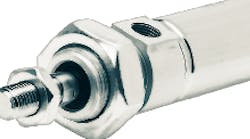Authored by: Alfred F. Perz Edited by Kenneth J, Korane Key points: Resources: Contact the author at: [email protected] |
Regulated compressed air is widely used in industry for a number of reasons, safety from electrocution being just one of them. A significant disadvantage, however, is the high cost of regulated air when compared to electricity. Replacing traditional mechanical regulators with digital switching devices is one way to significantly reduce the expense of generating regulated compressed air.
First consider how a conventional regulator works. With no system pressure, a spring pushes the diaphragm up and opens the orifice, as shown in the accompanying graphic. Applying input pressure lets gas flow through the open orifice to the load. Output pressure also applies a downward force on the diaphragm, counteracting the spring. Sufficient downward force will close the orifice.
When output pressure reaches required levels, forces on both sides of the diaphragm balance and the regulator maintains these conditions. Should output load increase, higher flow produces a greater pressure differential across the orifice and output pressure drops. Lower output pressure applies less force to the diaphragm and, in turn, causes the spring to open the orifice. This increases output pressure and restores the pressure balance across the diaphragm. Similar actions maintain output pressure when loads decrease.
Switching regulators operate in an entirely different manner. The most-significant feature is that a switching regulator is not a proportional valve, as is a conventional regulator. Rather, it operates either fully open or fully closed.
The regulator contains an actuator that opens and closes the control valve. A sensor monitors regulated output pressure and generates an electrical signal, proportional to pressure, and sends it to the processing electronics. If the output pressure is too low, the controller commands the valve actuator to open. If the output pressure equals or exceeds required pressure, the valve closes.
A small difference between upper and lower threshold pressures provides hysteresis, so the control valve will not chatter.
Output pressure with a switching regulator is not constant but inherently cyclical. Regulator design and system requirements determine the amplitude and frequency of this ripple. The accumulator serves as a low-pass filter and removes pressure spikes. Its size is dictated by overall system requirements.
Tests of prototypes show that when driving loads equivalent to a small air tool, switching regulators consume up to 38% less energy than conventional regulators.
The major reason is the control valve: Being either on or off instead of variable provides a system that is considerably more efficient. In both conventional and switching regulators, overall efficiency is a function of the energy dissipated in the control element (valve). The energy dissipated, E, is a function of pressure drop across the valve, P; and flow rate through the valve, F. This can be stated as:
E = f(PF).
In a conventional system, the magnitude of flow and pressure are real quantities determined by system dynamics. In a switching system, the energy dissipated is calculated when the control valve is open and closed. During the portion of the cycle when the valve is open, there is a large flow through the valve but a small pressure drop across it. Thus, the energy dissipated is small. When the valve is closed, pressure drop across the valve is high but flow is zero; the resulting energy dissipated is therefore zero. The total energy dissipated, the sum of both conditions, will be small.
Also, the switching pneumatic regulator is a mechanical implementation of an electronic switching voltage regulator used for the same reason, higher efficiency. An electronic regulator also typically converts a high unregulated voltage into a lower regulated voltage. The energy dissipated by its pass transistor is also significantly less than for its conventional or linear implementation.
